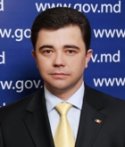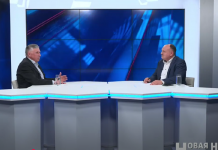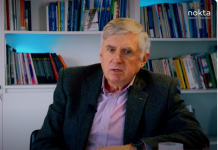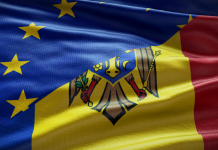With the Lisbon Treaty, the European Union has more capacity and more powerful tools to establish more of a presence and play a more effective role in resolving Transnistria’s frozen conflict, Victor Osipov, deputy prime minister of Moldova, told EurActiv in an exclusive interview.
Born in 1971, Victor Osipov is one of four deputy prime ministers of Moldova. He has held the position since September 2009. He is a former journalist.
He was speaking to Georgi Gotev.
To read a shortened version of this interview, focusing on Moldova’s political stalemate, please click here.
Mr Deputy Prime Minister: what is the purpose of your visit to Brussels?
I am in Brussels in the context of my duties for the government of Moldova. I am the deputy prime minister for the reintegration of my country. There is such a portfolio in the new cabinet because Moldova has faced a very serious problem since its existence as an independent country și namely the separatist regime on the left side of the Dniester river [Moldovan: Nistru, Russian: Dnestr].
You were appointed recently, in September 2009. Is reintegration a new portfolio?
Previously, the country had a ministry of reintegration, led by a minister. My position is that of deputy prime minister, which gives me more powers to coordinate all public actors towards the objective of reintegrating the Republic of Moldova. I am in Brussels as part of a round of discussions with the different players involved in the negotiating process for the resolution of the Transnistria problem.
My first visit in this round of talks was in Moscow because, without any doubt, the Russian Federation plays a major role in this problematic issue. Moscow is a mediator in the negotiation process and has the greatest influence in the region of Transnistria. A lot depends on the way the Russian authorities will formulate their objectives in the context of the efforts to resolve the problem. In Moscow, I met high-level representatives from the [resident’s administration, the Russian Foreign Ministry, the Russian Security Council and the Duma [the lower house of the Federal Assembly of Russia]. I also met scientists from the Academy of Sciences, etc.
Here in Brussels, I met a similar circle of representatives. I had a very important discussion with Å tefan Füle, the EU’s enlargement and neighbourhood policy commissioner, and with other high-level officials și including from the services of High Representative Catherine Ashton. I was very impressed by the interest of Commissioner Füle and by his sincere wish to seek ways to pursue the resolution process for the Transnistria problem.
I must say that the Transnistria problem is extremely complex, not only in terms of the negotiations but also in finding practical ways to solve the problems on the ground in the region with which the population is confronted.
Recently, the EU has increased its support și not only to the Republic of Moldova, but to the process of finding a solution to the Transnistria problem. The so-called Instrument for Confidence-building Measures between the East and West banks of the Dniester is benefitting from growing support from the European Commission. This is a new development.
At a recent meeting of the donor community for Moldova și which took place in Brussels on 26 March in the presence of our prime minister și it was decided that up to 15% of European Commission funding will be directed towards projects in the Eastern part of Moldova and the process of territorial reintegration of the country.
I should also mention a very important instrument, in place since 2006, called EUBAM și the EU’s monitoring mission of the Transnistria segment of the border between the Republic of Moldova and Ukraine. This mission facilitates contact between Ukrainian and Moldovan customs services and monitors the traffic of goods and the situation at the border crossing points in the segment where the Transnistrian administration is present.
Is it good news for you that the EU now has a more streamlined foreign policy and a High Representative for foreign affairs, who will lead a powerful European External Action Service?
Definitely, because now the Union has more capacity and I understand that the EU leaders wanted precisely this și to have more powerful tools to be more present and more effective internationally. We realise that all these instruments are still in the construction phase. Ms Ashton has a very heavy task. The results of these efforts will be very important, along with the place that the Transnistrian problem will occupy on the agenda of the EU and its new institution.
Our task here is to attract attention to the Transnistrian problem, precisely so that it will occupy a higher place in the foreign and security policy agenda of the EU. We will always seek a solution through peaceful means, but we should never forget that we are talking about a conflict. We are talking about an administration [in the city of Tiraspol] that has and is developing military capabilities and a very fragile situation that could deteriorate and create risky situations in the East of Europe. This affects the Republic of Moldova, Ukraine, Russia and Romania și because Romania is not indifferent to the developments și and other countries from the region. Experiences from other frozen conflicts show that it is not a good idea to wait until a major incident happens.
Like in Georgia in August 2008?
I don’t like this analogy and I would not refer to it when talking about Transnistria. We would like to develop pre-emptive and proactive initiatives to minimise risks in the case of the Transnistrian conflict. Right now, we have a very worrying incident: a freelance journalist has been arrested in Tiraspol și Ernest Vardanian, who is from the region of Transnistria și and the accusations brought against him appear very far-fetched. The risk potential of this region remains very high, in spite of our efforts to keep the peace.
All the frozen conflicts in the post-Soviet space have the same characteristic și they are an obstacle for former Soviet states to prevent them from getting closer to the EU. Do you share this analysis?
I understand your question, but I don’t want to speculate. At the official level, Russia’s positions and intentions do not express such a thing. I don’t know if there is a clear-cut vision in the Russian Federation on how to strategically approach the resolution of the Transnistrian conflict. I don’t know if the assumption in your question is true or not. But I know that there are circles in Russia, in Ukraine, in Tiraspol of course, and even in the Republic of Moldova who strive to perpetuate this situation, because it provides them with opportunities to benefit, mainly financially and economically, from the status quo.
There are enormous sources of revenue as a result of the conflict. Transnistria consumes gas, but doesn’t pay for it. The debt accumulated, as far as we know, is over $2 billion. There is big money and big interests in Transnistria.
How is it possible to consume gas and not pay for it? Is Gazprom such a generous donor?
It’s the administration of Tiraspol that doesn’t pay for the gas supplies. The sums due are considered as debt by the Republic of Moldova, because in this case the sovereign player is the Republic of Moldova. I repeat: I don’t know what the Russian strategy is, but for sure it is influenced by the existence of multiple interests și of economic, military, political and nationalistic natures.
And corruption?
Without any doubt. Nobody knows what happens in that region, which is outside the reach of any international monitoring instruments. A regime that is unrecognised internationally is not monitored internationally and therefore there is no insight on money laundering, the black economy, corruption, etc. These aspects make the Transnistrian problem much more complex that it can appear.
But I would like to say that what makes the Transnistrian conflict different from other conflicts in the post-Soviet space is that this conflict has no sub-strata, like ethnicity or religion, as in other areas. There is no fundamental difference between the left and right side of Dniester, there are no historic conflicts, and this gives us more chance to resolve the conflict.
But it also reveals that the nature of the Tiraspol regime is purely artificial. It is a result of the disintegration of the former USSR, when the central authorities and special services of that country used such a methodology to counter the centrifugal tendencies.
The EU will decide where to place the Transnistria problem on its agenda in the Council format. There are 27 countries and the Eastern members appear willing to give priority to the issue. What about the West? Do you have a strategy for raising awareness?
I have the impression that the older European democracies have also given more attention to the Transnistrian problem in the recent period. All EU countries unanimously approved a visa ban for the Tiraspol leaders. The Transnistrian problem is also a problem for security in Europe. It affects Ukraine as well, a bigger country that gets more attention from a Brussels perspective.
But let me answer your question. Unfortunately, the answer is ‘no, we don’t have such a strategy’. Moreover, the new leadership of the Republic of Moldova has found și much to their surprise și that the former authorities had not developed any kind of strategy for the reintegration of the country.
You mentioned Ukraine, a country with a new leadership as well. What changes do you sense in their attitude towards the Transnistria problem?
We are all very interested about the redefinition of Ukrainian politics. This is why we decided to leave Kiev until the latest stage of our tour of discussions. What I can tell you is the following: under its previous communist leadership, Moldova had deficient relations with its neighbours, including Ukraine. The new government has started to rebuild those relations. In the meantime, the leadership in Ukraine has changed. We already have signs of an improvement of relations. I just learned that a Ukrainian airline operator has opened a direct flight from Kiev to Chisinau for the first time. The demarcation of borders has begun. We have many more items on our agenda, but our expectation is that there will be good cooperation și including on the Transnistria dossier.
Following the meeting between the president of Ukraine, Viktor Yanukovich, and the OSCE chairman in office, Kazakh Foreign Minister Kanat Saudabayev, according to the official communiqué Ukraine will support the fundamental principle și which we share și of the independence, sovereignty and territorial integrity of the Republic of Moldova, while Transnistria would be offered a special status of autonomy.
Is this solution acceptable for you?
We stand for the same basic guidelines. All the remaining details will depend on the negotiation process. For us, it is important to ensure the independence and sovereignty of the state and the territorial integrity of the Republic of Moldova in the framework of which Transnistria would be offered special autonomous status. We already have an example with the autonomy of Gagauzia [an ethnic Turkish group with Orthodox Christian beliefs]. It may not be ideal, but it is an example of how a solution to a secessionist desire has been found through peaceful means.
We have been talking about reintegration, but European integration is an important issue as well. The most powerful locomotive for the EU integration of Moldova is your neighbour Romania, isn’t it?
I wouldn’t speak of any locomotive being more powerful than another. I think that the most powerful locomotive has to be the Republic of Moldova itself. The help you need, you can get yourself. The country needs to undergo internal reforms and the new Moldovan government sincerely wants those reforms and is striving to have those reforms pushed through.
Indeed, for us, the Romanian integration process is much easier to study, because we speak the same language and there is a strong relationship between us, because the majority of the population in both countries is part of the same people. Obviously, this is an advantage.
The period when it was not politically correct to describe the language spoken by Moldovans as Romanian is over, isn’t it? I remember former President Vladimir Voronin, who insisted on calling it ‘the state language’ rather than Romanian…
I think that period is over, even if this strategy of creating an identity that is different and distinct from the natural identity of the Moldovan population has been promoted for decades, from the Soviet period, and even if its remnants remain.
Unfortunately, some political forces still ride on those strategies, be it for the lack of a project or ideas or because their dignity is so low that they play with such sensitive issues. It’s a sorry strategy and the country has lost a lot of energy in this debate about its identity.
The opinion of the new leadership of the country is that there is nothing to debate. We must leave this subject behind us and spend our energy on the real, important issues.







